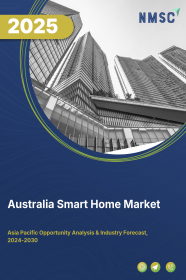
Asia-Pacific Smart Home Market by Product Type (Smart Lighting, Smart Home Security & Surveillance, Smart Entertainment, and Smart Appliances), by Communication Protocol (Wi-Fi, Zigbee, Z-Wave, Bluetooth, and Thread), by Smart Home Hubs (Standalone Hubs and Built-in Hubs), by Voice Assistants Integration (Amazon Alexa, Google Assistant, Apple Siri, and Others) – Opportunity Analysis and Industry Forecast, 2024–2030
Industry: Retail and Consumer | Publish Date: 15-Feb-2025 | No of Pages: 257 | No. of Tables: 175 | No. of Figures: 140 | Format: PDF | Report Code : RC2277
US Tariff Impact on Asia-Pacific Smart Home Market
Trump Tariffs Are Reshaping Global Business
Asia-Pacific Smart Home Market Overview
The Asia-Pacific Smart Home Market size was valued at USD 30.45 billion in 2023, and is predicted to reach USD 121.56 billion by 2030, at a CAGR of 21.9% from 2024 to 2030. A smart home, alternatively termed a connected home, describes a dwelling equipped with sophisticated technology and automation systems facilitating the centralized control and surveillance of diverse household devices, appliances, and security components through an integrated network. These intelligent home automation devices are remotely administered and frequently react to voice directives or predetermined schedules, augmenting convenience, energy conservation, and security for residents. Common features of connected homes encompass smart thermostats, lighting setups, security cameras, voice-activated assistants, and other interconnected devices aimed at enhancing the overall residential lifestyle.
High Smartphone Penetration Rates Drives the Market Growth
The Asia-Pacific region is poised to experience a surge in demand for the smart home market share, largely driven by the prevalence of high smartphone penetration rates, particularly in countries such as China and India. These countries boast substantial smartphone ownership, laying a robust groundwork for the widespread adoption of connected home devices.
For instance, in 2022, approximately 72% of the Chinese population owned smartphones, with projections indicating that this figure will soar to around 83% by 2027. The total number of smartphone users in 2022 surpassed one billion, facilitating easy control and management of connected home gadgets through dedicated mobile apps. This accessibility, coupled with familiarity with smartphone interfaces, renders connected home technology increasingly appealing and user-friendly, thereby fueling its popularity among Chinese consumers.
Presence of Key Market Players Boosts the Market Growth
Moreover, the Asia-Pacific smart home market growth is further propelled by the presence of key market players such as Samsung and LG. These industry giants are actively engaging in various strategies within the region, including product launches aimed at enhancing the home automation ecosystem.
For instance, in January 2023, Samsung introduced the SmartThings Station, a new addition to its connected home lineup. This innovative product seeks to elevate the connected home experience by centralizing control and connectivity.
Serving as a hub for various smart devices, the SmartThings Station enables users to seamlessly manage and monitor their connected home ecosystem. This launch underscores Samsung's steadfast commitment to advancing the Asia-Pacific smart home market through integrated and user-friendly solutions that streamline connected homes and enhance overall consumer convenience.
Security and Privacy Apprehensions Restrains the Market Expansion
The Asia-Pacific smart home market growth encounters a significant obstacle due to concerns surrounding security associated with these interconnected systems. Devices such as thermostats, cameras, and door locks are susceptible to hacking, posing risks to the privacy and safety of occupants.
This vulnerability often arises from weak or easily guessable passwords and inadequate security measures within Wi-Fi networks. Hackers exploit these vulnerabilities to gain unauthorized access, potentially manipulating devices or accessing sensitive data.
To address these risks, connected homeowners must prioritize robust password practices, regularly update device firmware, and fortify their home networks to diminish the likelihood of cyber-attacks and safeguard their connected homes against potential breaches.
Integration of Blockchain Technology into Smart Home Devices Presents Lucrative Opportunities for Market Expansion
The incorporation of blockchain technology, renowned for its robust security and transparency features, holds considerable promise in fortifying the security and privacy of smart home systems.
This technology achieves heightened security measures by encrypting and securely storing sensitive connected home data, affording users control over the individuals authorized to access their information, and mitigating the risk of unauthorized intrusion.
Through blockchain, device identities are verified, ensuring that only trusted devices interact within the connected home network. Additionally, blockchain facilitates task automation via tamper-proof smart contracts. Furthermore, blockchain technology decentralizes device control, thereby reducing vulnerabilities and enabling transparent management of access control and permissions.
By integrating blockchain into smart homes, security and privacy are augmented, culminating in a safer and more confidential connected home environment. Consequently, this integration is anticipated to create significant growth opportunities within the Asia-Pacific smart home market.
China Dominates the Asia-Pacific Smart Home Market Share
China stands out with its remarkable smartphone penetration rates, laying a sturdy groundwork for the widespread embrace of smart home devices. By 2022, nearly 72% of the Chinese populace owned smartphones, with projections indicating a rise to around 83% by 2027.
Surpassing the one billion marks, the total number of smartphone users in 2022 fosters an environment where consumers effortlessly control and manage their connected home gadgets via dedicated mobile apps. This widespread ownership and familiarity with smartphone interfaces significantly bolster the appeal and user-friendliness of connected home technology, fueling its popularity among Chinese consumers.
Moreover, China's leading tech giants, including Alibaba, Tencent, and Xiaomi, spearhead innovation within the connected home market. They consistently churn out cutting-edge connected home products equipped with advanced features and seamless integration.
These innovations span voice-controlled assistants, AI-driven home automation, and IoT ecosystems, all geared towards enhancing the convenience and functionality of connected homes. Consequently, consumers are drawn to these groundbreaking solutions, driving the growth of the smart home market in China.
Furthermore, China experiences a surge in IoT device adoption, witnessing a plethora of interconnected smart gadgets flooding the market. From smart thermostats to connected appliances, the proliferation of IoT devices fosters a comprehensive connected home ecosystem.
Globally, the count of Internet of Things (IoT) devices is poised to nearly double, soaring from 15.1 billion in 2020 to over 29 billion by 2030. By 2030, China is projected to claim the largest share of IoT devices, boasting approximately 8 billion consumer devices in use.
This surge is fuelled by the convenience and efficiency offered by IoT devices, that render homes more innovative and responsive to residents' needs. Consequently, the rapid expansion of IoT in China significantly contributes to the advancement of the smart home market within the country.
Indonesia to Witness a Substantial Growth in the Asia-Pacific Smart Home Market
Government incentives and growing eco-consciousness drive consumer investment in smart home solutions such as energy-efficient lighting, smart thermostats, and solar panels. These technologies empower homeowners to monitor and curtail their energy consumption, aligning with sustainability objectives and reducing carbon footprints.
In 2022, MPCT Indonesia unveiled a four-part mission, with its initial aim being to support decarbonization efforts, targeting a 50% reduction in emissions to aid in achieving the country's NDC goals. Additionally, the organization seeks to cultivate and foster the emergence of ten green business unicorns in Indonesia, establish a network of influential business leaders and policymakers dedicated to the nation's sustainable growth and decarbonization, and identify and empower numerous change agents to spearhead sustainability initiatives across diverse organizations and sectors.
With Indonesia's emphasis on green initiatives, connected homes assume a pivotal role in advancing energy efficiency and contributing to a cleaner, more sustainable future, consequently driving their demand in the market. Furthermore, the flourishing Indonesian economy, coupled with the increasing disposable income of its populace, creates a conducive environment for the smart home market's expansion.
As per the Asian Development Outlook (ADO) 2022, Indonesia's economic landscape witnesses a consistent upswing in consumer spending and manufacturing activity, propelled by rising incomes, employment opportunities, and heightened consumer confidence.
Additionally, the investment sector experiences notable gains, buoyed by growing demand, improved business conditions, and a resurgence in credit availability. As more Indonesians enjoy augmented purchasing power and economic optimism, the allure of innovative and convenient home appliances, including connected home devices, continues to escalate.
Competitive Landscape
Several market players operating in the Asia-Pacific smart home industry include LG Electronics, ASSA ABLOY, Amazon Inc., Samsung Electronics, Sony, Emerson Electronic Co., Johnson Controls International PLC, Centrica Connected Home Limited, Resideo Technologies Inc., Apple Inc., and others.
Asia-Pacific Smart Home Market Key Segments
By Product Type
-
Smart Lighting
-
Smart Bulbs
-
Smart Light Strips
-
Smart Switches
-
-
Smart Home Security and Surveillance
-
Smart Cameras
-
Video Doorbells
-
Smart Locks
-
Security System
-
-
Smart Entertainment
-
Smart TVs
-
Smart Speakers
-
Streaming Devices
-
-
Smart Appliances
-
Smart Refrigerators
-
Smart Ovens
-
Smart Washing Machines
-
Smart Dishwashers
-
Smart Home HVAC Management
-
Other Smart Appliances
-
By Communication Protocol
-
Wi-Fi
-
Zigbee
-
Z-wave
-
Bluetooth
-
Thread
By Smart Home Hubs
-
Standalone Hubs
-
Built-in Hubs
By Voice Assistants Integration
-
Amazon Alexa
-
Google Assistant
-
Apple Siri
-
Others
By Smart Home Compatibility with Smartphones
-
iOS
-
Android
By Installation
-
DIY Installation
-
Professional Installation
By Sales Channel
-
Online Retailers
-
Retailers
By Country
-
China
-
Japan
-
India
-
South Korea
-
Australia
-
Indonesia
-
Singapore
-
Taiwan
-
Thailand
-
Rest of Asia-Pacific
REPORT SCOPE AND SEGMENTATION:
|
Parameters |
Details |
|
Market Size in 2023 |
USD 30.45 Billion |
|
Revenue Forecast in 2030 |
USD 121.56 Billion |
|
Growth Rate |
CAGR of 21.9% from 2024 to 2030 |
|
Analysis Period |
2023–2030 |
|
Base Year Considered |
2023 |
|
Forecast Period |
2024–2030 |
|
Market Size Estimation |
Billion (USD) |
|
Growth Factors |
|
|
Countries Covered |
10 |
|
Companies Profiled |
10 |
|
Market Share |
Available for 10 companies |
|
Customization Scope |
Free customization (equivalent up to 80 working hours of analysts) after purchase. Addition or alteration to country, regional, and segment scope. |
|
Pricing and Purchase Options |
Avail customized purchase options to meet your exact research needs. |
KEY PLAYERS
-
LG Electronics
-
ASSA ABLOY
-
Amazon Inc.
-
Samsung Electronics
-
Sony
-
Emerson Electronic Co.
-
Johnson Controls International PLC
-
Centrica Connected Home Limited
-
Resideo Technologies Inc.
-
Apple Inc.

















 Speak to Our Analyst
Speak to Our Analyst




















